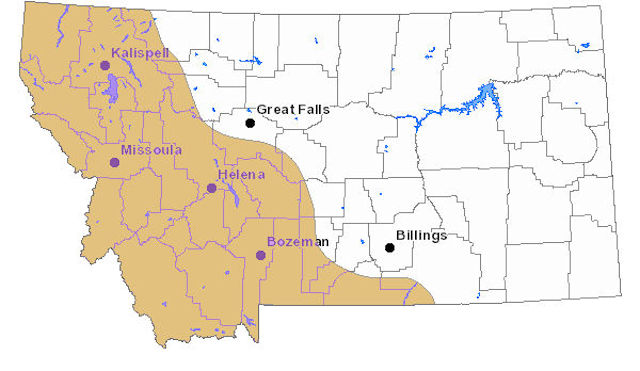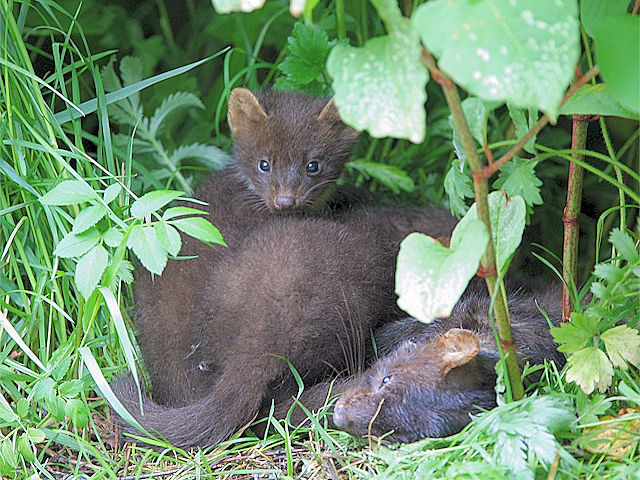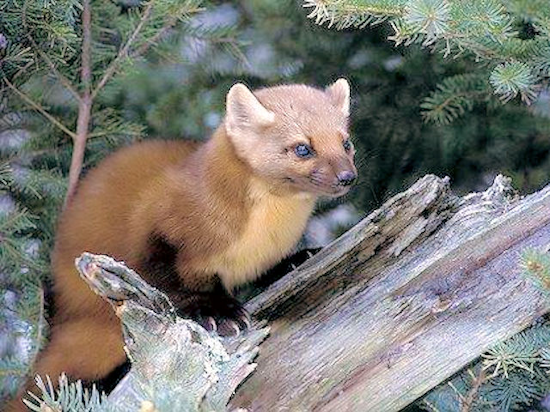Total length: 21 to 26 inches. Weight: 1.5 to 2.75 pounds.
Habitat: Primarily a boreal animal preferring conifer or mixed wood forests. Uses deadfall and snags as den sites.
Food Habits: Eats a variety of animal and plant materials associated with the mature forest. Is an opportunistic feeder that primarily feeds on a variety of small mammals.
Life History: Spends most of its time in the trees and is primarily nocturnal. Dens in hollow logs and trees. Mates during summer with young born during April. Exhibits delayed implantation and 8 to 9 month gestation. Average litter is 2 to 4.
Similar Species: Mink - has white patch on chin. Fisher - larger, dark brown, grizzled head and back. Red fox - white tip on tail.
Marten are woodland animals. American marten are sometimes confused with the European pine marten and the Russian sable, both of which are different species of martens. Uncontrolled fires, clear cutting lumber practices and trapping pressures caused a significant decline in marten populations from the late 1800's to the 1940's when trapping seasons for martens were closed in most states and Canadian Provinces. Since that time protection and the reintroduction of martens into acceptable habitats has proven to be a great success. Martens are currently present in 17 states and harvested by trapping in 10 states.
 Description
Description
Marten have silky fur with guard hairs of about
1 1/2 inches in length. Colors vary from lighter
buffs to darker browns and many marten exhibit
throat patches that are orange in color or
sometimes creamy white.
Males are consistently larger than females. Average males are 2 to 3 pounds in weight, with overall lengths of 25 to 30 inches including a furred tail of 9 to 12 inches. Tails are usually the darkest color on the individual animals. Females are about 1/3 smaller than males in all sections.
Martens have 38 teeth, including 4 sharp canine teeth and flattened molars to allow chewing of foods.
The marten has five toes on each foot, however, the toe that is similar to our thumb is reduced in size and usually does not appear in tracks left by the marten.
Like other mustelids, martens have a pair of scent glands located near the anus. The musk is released from these glands when the marten is excited and the odor is not as objectionable or as powerful as mink, weasel or skunk musk. Marten also have a large gland on their stomachs which gives off odors during the mating season.
Semi-retractable claws on each foot are extended to aid the marten in climbing and killing prey species and the ability to retract the claws while running keeps the claws sharp at all times.
 Reproduction
Reproduction
Marten mate in July in most regions and the
gestation period varies from 220 to 275 days
because implantation is delayed. The length of
daylight seems to trigger the final development
of the offspring, which usually number 1 to 4.
Litter sizes of 3 seem to be mot common.
Males may breed with more than one female and the females are solely responsible in the raising of the young.
Although juvenile martens reach adult sizes at 4 to 5 months of age, they usually do not breed until their second year of life, which allows their first littler at three years of age.
Habits
Martens are active primarily at night. An
extremely alert animal, marten move quickly
through the trees ad over land as a normal
activity. A high metabolic rate requires regular
feeding and marten seem to be always hunting.
Except for breeding seasons, marten are not sociable with others of the same species and the animals lead mostly solitary lives.
Although marten seem to prefer not to et wet, they can swim and the species frequently hunt around mountain streams. Spawning fish are occasionally killed in shallow water streams when the temptation to kill is greater than the fear of getting wet.
The species is territorial during the bulk of the year, and male territories are larger than female territories. The amount of cover and the availability of foods probably influence the size of the territory, with territories being larger when cover and prey species are sparse. A female territory can be as small as one square mile in good habitats, and several times that in poorer habitats. Males often cover 5 to 10 miles regularly, and male territories usually overlap the ranges of both other males and female marten.
Coverage of territories is irregular as marten do not seem to have regular circuits and established trails are seldom followed far. However, generation after generation of marten will usually cross and recross trails at nearly the same laces for one reason or another. Traveling is interrupted by rain, strong winds and strong snowstorms.
Dens in cavities in tress are used irregularly. Marten often seek out a temporary den to rest after feeding.
Marten are highly skilled tree climbers and they can literally gallop p a tree and run over the branches in pursuit of prey. At times, marten will travel from tree to tree, and available trees are used as refuge from pursuit.
Marten use the same type of habitat required by red squirrels and red squirrels appear to be an important part of the winter diet of marten in many areas. The most commonly eaten food is the redbacked vole, meadow mice and white footed mice. Aggressive predators, marten will attack and kill the much larger snowshoe hares and marmots.
Diet varies according to season and insects may be eaten when available and marten often scavenge carcasses of deer and moose, returning regularly to feed. Ground and tree nesting birds and their eggs are another important marten food.
General
Marten frequently escape predators with their
quickness and tree climbing abilities. Fisher
occasionally kill marten and they have the
ability to catch a marten on the ground or in
trees. Large owls also kill marten occasionally
and most other predators don't have much of a
chance because marten seldom venture far from
protective cover.
The solitary nature of marten coupled with the infrequent use of the same dens keeps marten relatively free of internal and external parasites. Mange Marten serve a variety of prey species by helping to keep populations in check. In many mountainous locations marten are the only major predator remaining in the high altitudes during the winter conditions.
Marten populations do not have an impact upon man's crops or livestock. The species prefers wilderness or semi-wilderness habitats where contact with man is rare.
A marten is considered to be old at 9 years of age.




